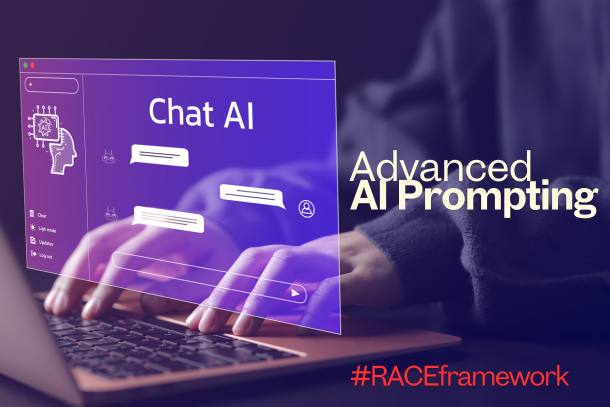A practical guide to the RACE Framework for advanced AI prompting.
If you want to save time, produce high-quality outputs, and achieve consistent results when using AI tools like ChatGPT, Gemini, Claude, and Copilot, mastering the art of prompt engineering is essential.
The quality of your prompts determines how effectively these tools can deliver on your specific goals. Crafting precise and detailed prompts is essential to harness the full potential of these technologies.
One proven method to enhance your prompt engineering skills is the RACE Framework, which stands for Role, Action, Context, and Execute. This easy-to-remember approach ensures that AI-generated content will enhance the quality and relevance of the outputs.
What does the RACE Framework stand for?

- Role: Define the specific role you want the AI to assume. This sets the perspective and tone for the response.
- Action: Specify the task you want the AI to perform. Use precise verbs like “write,” “summarise,” or “analyse” to direct the AI’s function.
- Context: Provide relevant background information to frame the AI’s response. This may include details about the target audience, desired tone, or specific content to reference. Including context helps the AI generate more accurate and tailored outputs.
- Execute: Outline any specific formatting or structural requirements for the output. This could involve specifying bullet points, headings, or other organisational elements to ensure the response meets your presentation standards.
Applying the RACE Framework: A Step-by-Step Guide
To effectively utilise the RACE Framework, follow these steps:
- Define the Role: Determine the expertise or perspective you want the AI to embody. For example: “You are an expert social media marketer with proficiency in creating engaging Instagram captions.”
- Specify the Action: Clearly articulate the task. For instance: “Your task is to write an Instagram caption for a new product launch.”
- Provide Context: Offer background details to inform the response. Example: “The product is a sustainable water bottle aimed at environmentally conscious consumers. The tone should be upbeat and inspiring.”
- Execute with Precision: State any formatting preferences. For example: “The caption should include relevant hashtags and a call to action encouraging followers to visit our website.”
Example Prompt Using the RACE Framework
“You are an expert social media marketer with proficiency in creating engaging Instagram captions. Your task is to write an Instagram caption for a new product launch. The product is a sustainable water bottle aimed at environmentally conscious consumers. The tone should be upbeat and inspiring. The caption should include relevant hashtags and a call to action encouraging followers to visit our website.”
Benefits of Using the RACE Framework
- Clarity: Provides clear instructions, reducing ambiguity in AI responses.
- Relevance: Ensures outputs are tailored to specific needs and audiences.
- Efficiency: Streamlines the prompt creation process, saving time and effort.
- Consistency: Maintains uniformity across multiple AI-generated outputs.
Tips for Effective Prompt Engineering with RACE
- Be Specific: The more detailed your prompt, the better the AI can deliver the desired outcome.
- Use Clear Language: Avoid jargon or ambiguous terms to prevent confusion.
- Iterate and Refine: Experiment with different prompts and adjust as needed to achieve optimal results.
- Provide Examples: When possible, include examples to guide the AI in understanding your expectations.
By incorporating the RACE Framework into your interactions with generative AI tools, you can significantly enhance the quality and relevance of the outputs. This structured approach empowers you to communicate your needs effectively, ensuring that AI-generated content aligns with your objectives and resonates with your target audience.
Want to know whether it’s worth paying for ChatGPT? Check out the blog: Is a Paid Subscription of ChatGPT Worth It?




